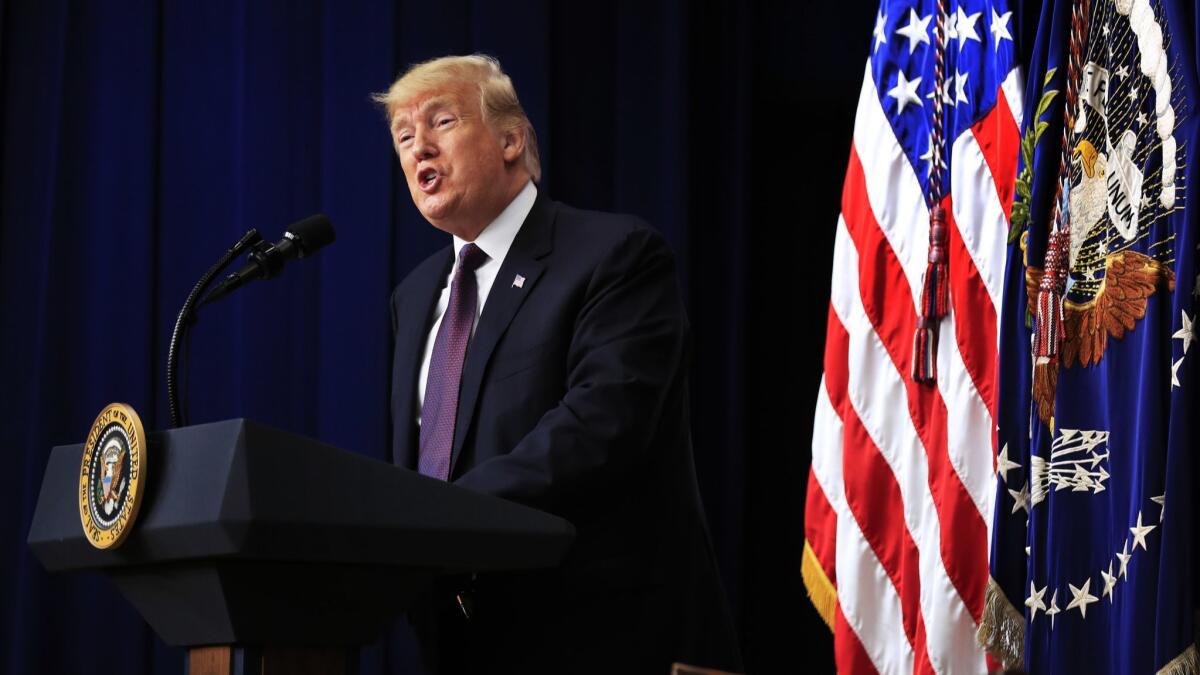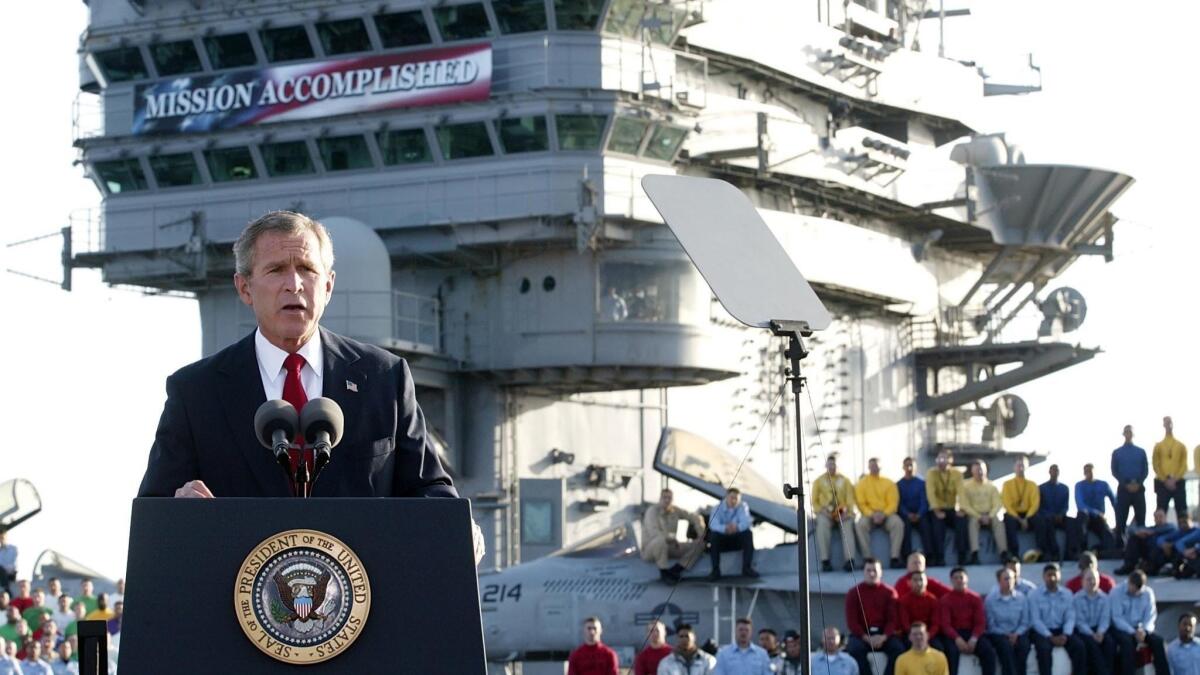Why the ‘P’ word — propaganda — might be best for what we’re seeing on our TV screens

The “P” word.
It’s a pivotal part of the story on Donald Trump’s camera-lit path to the White House. The media, of course, rarely if ever uttered the taboo term on air, even as demonstrators shouted it at cameras during women’s marches and scrawled it across protest signs they brandished outside the White House.
But here we are, two years in, tiptoeing around The Word That Cannot Be Said. Let’s just call it what it is: Propaganda.
The state-sponsored spread of deliberate misinformation is not a “half-truth,” “distortion of reality” or “the president’s loose relationship with the facts,” as many a mainstream news correspondent and pundit have said. It’s also not “a bold truth” or simply “The Truth” as many voices on the right have asserted.
The doctored “karate-chop” video of CNN’s Jim Acosta allegedly manhandling a White House intern at a press conference, posted by press secretary Sarah Sanders last week, was not a matter of differing perspectives, dueling truths or conflicting political beliefs. Nor were the White House transcripts of public meetings where Trump’s flubs were mysteriously omitted, altered presidential approval ratings posted by Don Jr. before the midterms or the cropped photo that Sean Spicer insisted was proof of the biggest inaugural crowd ever. “Period!”
They were all cases of purposefully manufactured narratives, disseminated from the highest levels of government, sometimes with the help of adversary nations, to sway public opinion, quash dissenting voices and consolidate power.
I know, it’s not half as fun as Kellyanne Conway’s wacky spiel on alternative facts or just Trump being Trump. In fact, it’s associated with some of the uglier chapters of the 20th and 21st centuries.
Propaganda is something most of us read about in history class and wondered how people were so easily duped. Certainly they saw through such obvious attempts to manipulate? Its use dates back well before Nazi Germany and Cold War Russia and stretches up to present-day China, Saudi Arabia and North Korea. It arrives in the form of fake Facebook accounts created abroad and meant to influence our elections, or surveillance video from a Turkish embassy where Saudi operatives sought to cover up a murder by posing as their victim.
It’s the mark of a country we never wanted to be: a nation that divides its own people and pits them against one another. And it never ends well.
Democracy relies on people being informed...A society [with] their own set of facts is absolutely devastating.
— Stephan Lewandowsky, cognitive scientist
“On page one of any political science textbook it will say that democracy relies on people being informed about the issues so they can have a debate and make a decision,” Stephan Lewandowsky, a cognitive scientist who studies the persistence and spread of misinformation, told the BBC shortly after Trump’s inauguration. “Having a large number of people in a society who are misinformed and have their own set of facts is absolutely devastating and extremely difficult to cope with.”
No wonder fabrications from the Oval Office are often viewed as singular events or anomalies caused by an outsider who crashed Washington rather than age-old propaganda. It’s too frightening to admit the calls are coming from inside the house.
Orwellian state messaging has even permeated the TV series we binge for entertainment. Shall we be terrified by “The Man in the High Castle” or “The Handmaid’s Tale” tonight, honey? We’ve also been desensitized by reality TV, the modern-day answer to the documentary, where scripted moments of drama are an acceptable and almost expected part of serialized “reality.”
Take Trump’s old show “The Apprentice,” where the bankruptcy-prone son of a real estate mogul was reimagined into a self-made billionaire. The lines between fantasy and reality weren’t just blurred by “Survivor” producer Mark Burnett, they were erased entirely and redrawn by some of television’s best alchemists.
It was all fun and games and great ratings until someone got elected to office.
With such deep cultural references as “You’re Fired!” permeating American society, it’s no wonder the idea of propaganda seems like a relic from the paranoid 1950s or a cruel fate meant for other countries with fist-shaking Ayatollahs or military strongmen. We’ll stick with Rosie the Riveter, thanks, a nostalgic symbol of the domestic war effort. She smiled on the factory floor while assembling deadly munitions. What could be cuter? And please don’t say Flo, the perky Progressive Insurance lady.

There’s of course nothing new about politicians evangelizing their version of events or extolling their successes. George W. Bush gave the “mission accomplished” thumbs up shortly after the U.S. invaded Baghdad, though the mission was predicated on faulty intel and the war would drag on for over a decade. Barack Obama graciously accepted the Nobel Peace Prize as the drone strikes he ordered killed civilians in Pakistan.
War propaganda is as old as, well, war. And hard spin is used just as frequently to influence in diplomatic times. Leaders must always look like leaders. But perhaps you’ve heard: This presidency isn’t like the others.
In July when speaking to a group of veterans in Kansas City about his distrust of the media, Trump said it plainly: “Just remember, what you’re seeing and what you’re reading is not what’s happening.”
He couldn’t have been more truthful, at least in that instance.
The altered Acosta video, which appeared to have been uploaded by Sanders from the conspiracy-minded website InfoWars to her Twitter feed, was used to justify banning the CNN correspondent from future press briefings, and now CNN is suing. No word yet if Final Cut Pro will be hired as the next press secretary.
That wasn’t the only clumsy attempt at recasting a moment already witnessed by millions. Recently released government documents acquired through a Freedom of Information request confirmed what many suspected following Trump’s first days in the White House. The Guardian reported that “a government photographer edited official pictures of the inauguration to make the crowd appear bigger” after a request by Trump “who was angered by images showing his audience was smaller than Barack Obama’s in 2009.”
He called the correction “fake news,” a phrase that Trump seems to have brought into the lexicon to muddy the waters.
Trump propaganda is of course reflected and fed by his unofficial media wing, Fox News. It’s a back-and-forth feeding frenzy that’s become so acceptable at the network that even two of its star hosts campaigned on stage alongside the president at political rallies.
So many ethical lines have been crossed in the past two years, it’s doubtful anyone — let alone Sean Hannity — can locate where the defining boundaries of “normal” used to be.
There are a few who can see through the gentle euphemisms — namely, the old guard who remember a time when Russia was the enemy, presidents showed their tax returns and Gold Star families were honored by their country’s Commander in Chief. Military analyst Ralph Peters, a retired U.S. Army lieutenant colonel, left Fox News but not before stating: “With the rise of Donald Trump, Fox did become a destructive propaganda machine. And I don’t do propaganda for anyone.”
Still, the slow drip of repeated terms like “fake news” wears a groove that’s hard to get out of, even when the real fake news is coming from the White House and undermining democratic institutions critical to our nation’s health. And let’s not forget the sharpest tool of all: fear. Beware of caravans, Nancy Pelosi, transgender bathrooms, black women journalists, yadda, yadda.
Many in the media must have expected Trump to develop from a reality-show ringleader to a world leader when they used non-corrosive terms like “distortions” and “half-truths” while correcting his 2017-era falsehoods.
But by his second year in office, even the euphemisms got tired. Now several mainstream journalists use the L-word: lie.
Perhaps the “P-word” is next.
ALSO
‘Stop interrupting’: How Trump turned his news conference into a post-election spectacle
Hate crimes and Frontline’s “The Facebook Dilemma” highlight the dangerous tribalism of social media
The rise and fall of Megyn Kelly and what it says about the state of the media
She said/he bellowed: The optics of the Ford/Kavanaugh hearings were as divided as America
More to Read
The complete guide to home viewing
Get Screen Gab for everything about the TV shows and streaming movies everyone’s talking about.
You may occasionally receive promotional content from the Los Angeles Times.







